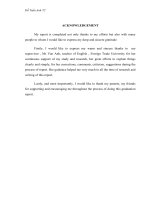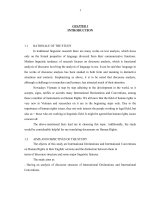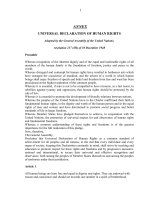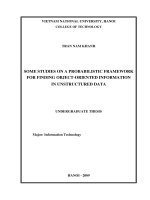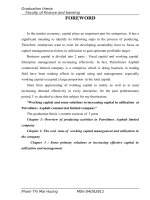some antmimic spider (salticidae) indian
Bạn đang xem bản rút gọn của tài liệu. Xem và tải ngay bản đầy đủ của tài liệu tại đây (1.97 MB, 18 trang )
Arthropoda Selecta 25(4): 403420
â ARTHROPODA SELECTA, 2016
Taxonomic notes on some ant-mimicking jumping spiders
(Araneae: Salticidae) from India
ềờủợớợỡốữồủờốồ ỗỡồũờố ợ ớồờợũợỷừ ỡúõỹồõốọớỷừ
ùúờừ-ủờờúớữốờừ (Araneae: Salticidae) ốỗ ẩớọốố
John T.D. Caleb
ổ.ề.. ấởồỏ
National Centre for Biological Sciences, Tata Institute of Fundamental Research, Bangalore 560 065, Karnataka, India.
E-mail:
KEY WORDS: Ant-like jumping spiders, Myrmarachne, Salticidae, India, redescriptions.
: -, Myrmarachne, Salticidae, , .
ABSTRACT. Five species of ant-mimicking jumping spiders are recorded from India: Myrmarachne
kuwagata Yaginuma, 1967, M. melanocephala MacLeay, 1839, M. plataleoides (O. Pickard-Cambridge,
1869), M. prava (Karsch, 1880), and M. ramunni Narayan, 1915. All these species are redescribed and illustrated in detail.
. : Myrmarachne
kuwagata Yaginuma, 1967, M. melanocephala
MacLeay, 1839, M. plataleoides (O. PickardCambridge, 1869), M. prava (Karsch, 1880), M.
ramunni Narayan, 1915.
.
Introduction
The genus Myrmarachne MacLeay, 1839 (s.lat.) is
characterized by its members exhibiting the Batesian
mimicry towards ants [Wanless, 1978; Yamasaki, Edwards, 2013; Yamasaki, Ahmad, 2013]. The genus consists of 229 described species [WSC, 2016]. Based on
the similarity of copulatory organs in some species groups
of Myrmarachne (s.lat.), Prúszyski [2016b] have erected nine new genera, to which 34 Myrmarachne species
have then been transferred. Of them, 24 species of Myrmarachne (s.str.) and one of Myrmaplata Prúszyski,
2016 have been recorded from India to date [WSC,
2016; Prúszyski, 2016b]. The members of Myrmarachne reported from India are poorly described and in
most cases are unrecognizable by the existing original
descriptions and illustrations [see Prúszyski, 1992].
This paper is devoted to detailed morphological
descriptions of the five Myrmarachne species collected from south India, namely: M. kuwagata Yaginuma,
1967, M. melanocephala MacLeay, 1839, M. plataleoides (O. Pickard-Cambridge, 1869), M. prava (Karsch, 1880) and M. ramunni Narayan, 1915.
Materials and methods
Spiders were collected from Araabath Lake and
the campus of Madras Christian College in the vicinities of Chennai City (erstwhile Madras), Tamil Nadu,
and from the campus of the National Centre for Biological Sciences, Bangalore, Karnataka. The specimens were photographed by means of DSLR Nikon
D60, 18-55 mm (for macro capability, the lens was
reversed and mounted on the camera body with help
of an attachment ring). The specimens were preserved
in 70% alcohol and examined by means of Leica
S8APO stereoscopic microscope; photographs were
obtained by means of Leica MC120 HD camera, with
the LAS core software. Male palps were detached and
studied. Female copulatory organs were removed by
using a fine surgical scalpel. The epigynes were cleared
in a 10% KOH solution. The studied specimens have
been deposited in the collection of the National Centre for Biological Sciences (NCBS), Bangalore. Descriptions are based on fresh specimens. All measurements are in mm. The format of descriptions, measurements and leg spination follow Yamasaki [2010]
and Yamasaki, Ahmad [2013]. Abbreviations used in
the text are as follows: ALE anterior lateral eye,
AME anterior median eye, di distal, md middorsal, PLE posterior lateral eye, PME posterior median eye, pd prodorsal, pr proximal, pv
proventral, RTA retrolateral tibial apophysis, rv
retroventral.
Taxonomy
Myrmarachne MacLeay, 1839
Type species: Myrmarachne melanocephala MacLeay, 1839
404
J. Caleb
Figs 1–5. Myrmarachne kuwagata Yaginuma, 1967. 1 — male body, dorsal view; 2 — ditto, lateral view; 3, 4 — ditto, front view;
5 — female body, dorsal view.
Рис. 1–5. Myrmarachne kuwagata Yaginuma, 1967. 1 — тело самца, вид сверху; 2 — тоже, вид сбоку; 3, 4 — тоже, вид спереди;
5 — тело самки, вид сверху.
Ant-mimicking Salticidae from India
405
Figs 6–10. The male of Myrmarachne kuwagata Yaginuma, 1967. 6 — body, dorsal view; 7 — ditto, ventral view; 8 — ditto, lateral
view; 9 — maxillae, labium, sternum and coxae; 10 — chelicerae, ventral view. Scale bars: 1 mm (6–9).
Рис. 6–10. Самец Myrmarachne kuwagata Yaginuma, 1967. 6 — тело, вид сверху; 7 — тоже, вид снизу; 8 — тоже, вид сбоку;
9 — максилла, лабиум, стернум и вертлуги; 10 — хелицеры, вид снизу. Масштаб: 1 мм (6–9).
Myrmarachne kuwagata Yaginuma, 1967
Figs 1–19, Map 1.
Myrmarachne kuwagata Yaginuma, 1967: 100, figs 3l–p; Ono
et al, 2009: 564, figs 37–39.
MATERIAL. INDIA: 1 #, 1 $ (NCBS-AR127, AR128), scrub
regions near Araabath Lake (13.123335°N, 80.136958°E), Tamil
Nadu, 21.73 m a.s.l., 18.08.2013, John T.D. Caleb.
DESCRIPTION. MALE. Total length 5.40; carapace 2.57 long, 1.41 wide; abdomen 2.35 long, 1.40
wide. Width of eye row I 1.19; II 1.17; III 1.27. Eye
size: AME 0.39, ALE 0.16, PME 0.07, PLE 0.19;
ALE–PME 0.28, ALE–PLE 0.65. Chelicerae length
1.48. Sternum length 1.50. Leg spination; Patella I rv
1; tibia I pv 5, rv 5; metatarsus I pv 2, rv 2; tibia II pv 1,
rv 3; metatarsus II pv 2, rv 2. Cephalic part flat dorsally, finely rugulose, covered with fine grey hairs (Figs 1,
6). Thoracic region clearly separated with deep furrow,
lower than cephalic region, convex dorsally, gradually
sloping posteriorly (Figs 2, 8). Chelicerae shorter than
carapace, black, rugulose, flattened dorsally and curved
outer edges (Figs 3, 4); chelicerae dentition with 6
promarginal teeth (5 proximal and 1 distal) and 7 ret-
406
J. Caleb
Figs 11–14. The female of Myrmarachne kuwagata Yaginuma, 1967. 11 — body, dorsal view; 12 — carapace, lateral view; 13 —
sternum and coxae; 14 — chelicerae, ventral view. Scale bars: 1 mm (11–13).
Рис. 11–14. Самка Myrmarachne kuwagata Yaginuma, 1967. 11 — тело, вид сверху; 12 — головогрудь, вид сбоку; 13 —
стернум и вертлуги; 14 — хелицеры, вид снизу. Масштаб: 1 мм (11–13).
romarginal teeth. Fang stout with a bump on the prolateral margin and a longer apophysis on the ventral
region (Figs 10, 15). Sternum dark, slender, slightly
overlapped by coxae I, II and III (Fig. 9). Legs dark
brown, except for light yellow segments on the first
two pairs of legs. Leg I with light yellow patella and
tibia, leg II with lighter, yellowish patella, tibia, metatarsus and tarsus (Figs 6–8). Abdomen almost oval,
covered with fine hairs (Fig. 1). Palps with rounded
tegulum, with U-shaped seminal reservoir in the 12 to
1 o’clock position; embolus with two coils, RTA twisted, strongly curved, S-shaped and well developed
flange (Figs 16, 17).
FEMALE. Total length 8.04; carapace 2.9 long, 1.35
wide; abdomen 4.00 long, 2.25 wide. Width of eye row I
1.23; II 1.22; III 1.38. Eye size: AME 0.38, ALE 0.13,
PME 0.05, PLE 0.21; ALE–PME 0.31, ALE–PLE 0.72.
Sternum length 1.64. Leg spination; Patella I rv 1; tibia I
pv 5, rv 5; metatarsus I pv 2, rv 2; tibia II pv 3, rv 3;
metatarsus II pv 2, rv 2. Coloration as in the male, but
differs in having a deep, narrow constriction between
cephalic and thoracic regions, thoracic region strongly
convex dorsally (Figs 5, 11, 12). Chelicerae with 6 teeth
on the prolateral margin and 7 teeth on the retrolateral
margin (Fig. 14). Coxa I yellowish, coxa II–IV dark
brown (Fig. 13). Thin dark brown stripes present on the
Ant-mimicking Salticidae from India
407
Figs 15–19. Chelicerae and copulatory organs of Myrmarachne kuwagata Yaginuma, 1967. 15 — chelicerae and fang, ventral view;
16 — palp, ventral view; 17 — ditto, retrolateral view; 18 — epigyne, ventral view; 19 — spermathecae, dorsal view. Scale bars: 0.5 mm
(15), 0.1 mm (16–19).
Рис. 15–19. Хелицеры и копулятивные органы Myrmarachne kuwagata Yaginuma, 1967. 15 — хелицера, вид снизу; 16 —
пальпа, вид внизу; 17 — тоже, вид сбоку-сзади; 18 — эпигина, вид снизу; 19 — сперматека, вид сверху. Масштаб: 0,5 мм (15), 0,1
мм (16–19).
408
J. Caleb
Map 1. Distributional records of Myrmarachne spp. in India.
Карта 1. Точки находок Myrmarachne spp. в Индии.
lateral margins of first two pair of legs (Figs 11, 12).
Epigyne with large, oval copulatory openings; sclerotized copulatory ducts thinner, forming twists before
reaching spermathecae; lateral pockets present just above
epigastric furrow (Figs 18, 19).
NATURAL HISTORY. Found among the scrub
sites near Araabath Lake.
REMARKS. Considering the geographic gap between the type locality of this species and the Indian
records (Map 1), the specimens from Tamil Nadu might
belong to a different species. However, due to the lack
of sufficient comparative data and specimens, the studied specimens have been provisionally assigned to M.
kuwagata.
Ant-mimicking Salticidae from India
409
Figs 20–25. The male of Myrmarachne melanocephala MacLeay, 1839. 20 — body, dorsal view; 21 — ditto, lateral view; 22 —
chelicerae, ventral view; 23 — maxillae, labium, sternum and coxae; 24 — palp, ventral view; 25 — ditto, retrolateral view. Scale bars: 1
mm (20–23), 0.1 mm (24–25).
Рис. 20–25. Самец Myrmarachne melanocephala MacLeay, 1839. 20 — тело, вид сверху; 21 — тоже, вид сбоку; 22 — хелицеры,
вид снизу; 23 — максилла, лабиум, стернум и вертлуги; 24 — пальпа, вид снизу; 25 — тоже, вид сбоку-сзади. Масштаб: 1 мм (20–
23), 0,1 мм (24–25).
410
J. Caleb
Figs 26–30. The female of Myrmarachne melanocephala MacLeay, 1839. 26 — body, dorsal view; 27 — sternum and coxae; 28 —
chelicerae and fang, ventral view; 29 — epigyne, ventral view; 30 — spermathecae, dorsal view. Scale bars: 1 mm (26, 27); 0.1 mm (29,
30).
Рис. 26–30. Самка Myrmarachne melanocephala MacLeay, 1839. 26 — тело, вид сверху; 27 — стернум и вертлуги; 28 —
хелицеры, вид снизу; 29 — эпигина, вид снизу; 30 — сперматека, вид сверху. Масштаб: 1 мм (26, 27); 0,1 мм (29, 30).
DISTRIBUTION. China, Korea, Japan [WSC,
2016], India (Chennai; Map 1).
Myrmarachne melanocephala MacLeay, 1839
Figs 20–30, Map 1.
Myrmarachne melanocephala MacLeay, 1839: 11, pl. 1, fig.
4; Edwards, Benjamin, 2009: 5, figs 1A–H, 2A–D, 3A–D, 4A–E,
5A–D; Yamasaki, Edwards, 2013: 15, figs 46–58; Yamasaki, Ahmad, 2013: 541, figs 32A–G, 33A–H, 34 A–C; Benjamin, 2015:
17, figs 17A–D, 18A–D, 19A–D.
For a complete set of taxonomic references see
WSC [2016].
MATERIAL. INDIA: 3 ##, 1 $ (NCBS-AR129–AR132),
Thirumullaivoyal (13.125090°N, 80.135712°E), 26.85 m a.s.l.,
18.08.2013, John T.D. Caleb; 1 #, 1 immature $ (author’s personal collection), Thirumullaivoyal (13.126197°N, 80.135966°E), 26.85
m a.s.l., 12.12.2013; 1 $ (author’s personal collection), Madras
Christian College (12.920297°N, 80.123583°E), Chennai, Tamil
Nadu, 32 m a.s.l., 25.07.2013, John T.D. Caleb.
DESCRIPTION. MALE. Total length 8.85; carapace 3.52 long, 1.90 wide; abdomen 3.95 long, 1.62
wide. Width of eye row I 1.49; II 1.42; III 1.66. Eye
size: AME 0.43, ALE 0.22, PME 0.05, PLE 0.24;
ALE–PME 0.30, ALE–PLE 0.75. Chelicerae length
3.15. Sternum length 2.01. Leg spination. Femur I md
0–1, pd 1; patella rv 1; tibia I pv 3, rv 4; metatarsus I pv
2, rv 2; tibia II pv 2–3, rv 0–3; metatarsus II pv 2, rv 2;
femur III pd 1; tibia III pv 0–1. Cephalic part dark
brown, slightly higher than thoracic region; finely rugulose, covered with fine grey hairs. Thoracic region
reddish, clearly separated with a distinct furrow, gradually sloping posteriorly (Figs 20, 21). Chelicerae shorter than carapace, brownish, rugulose, flattened dorsally chelicerae dentition with 10 promarginal teeth and
10 retromarginal teeth. Fang tapering gradually, slender with an apophysis (Fig. 22). Sternum brownish,
slender, slightly overlapped by coxae I, II and III (Fig.
23). Legs I and II lighter, yellowish, with dark stripe on
femur II. Coxa I orange, coxa II yellowish white. Leg
III and IV brownish, trochanter IV and patella IV white
(Figs 20, 21, 23). Abdomen elongate, with dorsal scutum
and a constriction; anterior region reddish brown, posterior region dark brown, covered with fine hairs uniformly (Fig. 20). Palps with rounded tegulum, with Cshaped seminal reservoir in the 2 to 3 o’clock position;
embolus with two coils. RTA twisted, strongly curved,
s-shaped, with developed flange (Figs 24, 25).
Ant-mimicking Salticidae from India
FEMALE. Total length 8.01; carapace 3.10 long,
1.53 wide; abdomen 3.96 long, 1.76 wide. Width of
eye row I 1.40; II 1.34; III 1.55. Eye size: AME 0.47,
ALE 0.26, PME 0.05, PLE 0.24; ALE–PME 0.33,
ALE–PLE 0.76. Sternum length 1.73. Leg spination.
Tibia I pv 5, rv 5; metatarsus I pv 2, rv 2; tibia II pv 3,
rv 3; metatarsus II pv 2, rv 2. Carapace coloration as in
the male (Fig. 26). Chelicerae with 7 teeth on the
prolateral margin and 8 teeth on the retrolateral margin
(Fig. 28). Legs I and II lighter yellowish, except coxa I
which is brownish. Legs III and IV brownish with
white trochanter IV and patella IV. Thin dark brown
stripes present on the lateral margins of first two pair of
legs (Fig. 26). Abdomen elongate, devoid of scutum,
with lateral white hairs near the weak constriction.
Faint white transverse markings seen on the dorsum
(Fig. 26). Epigyne with large, oval copulatory openings; copulatory ducts forming ∞-shaped twists before
reaching spermathecae; lateral pockets present just
above epigastric furrow (Figs 29, 30).
DISTRIBUTION. Pakistan to Indonesia [Edwards,
Benjamin, 2009; WSC, 2016]; the records from India
are shown in Map 1.
Myrmarachne plataleoides (O. Pickard-Cambridge,
1869)
Figs 31–54, Map 2.
Salticus plataleoides O. Pickard-Cambridge, 1869c: 68, pl. 6,
figs 61–65; Peckham, Peckham, 1892: 33, pl. 3, fig. 1.
Myrmarachne p.: Edmunds, Prószyński, 2003: 298, figs 1–7;
Edwards, Benjamin, 2009: 16, figs 7; Benjamin, 2015: 38, figs
29A–D, 30A–D, 31A–E.
Myrmaplata p.: Prószyński, 2016: 9, figs 1E–F, 2G, 3H.
MATERIAL. INDIA: 2 ##, 1 $ (NCBS-AR125, AR053,
AR057), 1 sub-adult $ (NCBS-AR126), the NCBS campus
(13.071137°N, 77.580543°E), Bangalore, 896.92 m a.s.l.,
18.05.2015, Rajesh Sanap & Zeeshan Mirza.; 1 # (NCBS-AR134),
Madras Christian College (12.919606°N, 80.122216°E), Chennai,
Tamil Nadu, 32 m a.s.l., 25.03.2013, John Caleb T.D.; 1 # (NCBSAR135), 1 sub-adult # (NCBS-AR133), same college
(12.917013°N, 80.120572°E), 32 m a.s.l., 9.05.2013, John Caleb
T.D. & Nagoor Meerasa Mohammed.
DESCRIPTION. MALE (NCBS-AR125). Total
length 7.76; carapace 3.26 long, 1.62 wide; abdomen
3.57 long, 1.45 wide. Width of eye row I 1.36; II 1.27;
III 1.53. Eye size: AME 0.45, ALE 0.20, PME 0.10,
PLE 0.22; ALE–PME 0.26, ALE–PLE 0.81. Chelicerae length 3.30. Sternum length 1.92. Leg spination.
Femur I pr 2–3, di 1; tibia I pv 4, rv 4; metatarsus I pv
2, rv 2; femur II pr 1, md 1, pd 1; tibia II pv 1, rv 2;
metatarsus II pv 2, rv 2; femur III pr 1–2, md 0–1, di 1;
femur IV pr 1. Cephalic part flat dorsally, finely rugulose, covered with fine grey hairs. Thoracic region
lower than cephalic region, convex dorsally, sloping
posteriorly (Figs 31, 32). Chelicerae nearly as long as
carapace, brownish with black tip near base of fang,
basal half flattened dorsally, later half distended (Fig.
31); chelicerae dentition with 5 promarginal teeth and
10 retromarginal teeth. Fang long and slender without
apophysis (Fig. 34). Sternum yellowish, slender, slightly
overlapped by coxae II (Fig. 33). All leg segments
411
orangish, except for white tarsus, trochanter IV and
patella IV (Figs 31, 32). Abdomen elongate-oval, covered with fine grey hairs (Fig. 31). Palps with rounded
tegulum, with C-shaped seminal reservoir in the 1 to 2
o’clock position; embolus with two coils. RTA short,
thick and pointed tip with broad base (Figs 35, 36, 45,
46).
FEMALE. Total length 9.59; carapace 3.72 long,
1.72 wide; abdomen 4.59 long, 2.16 wide. Width of
eye row I 1.45; II 1.38; III 1.69. Eye size: AME 0.50,
ALE 0.21, PME 0.07, PLE 0.22; ALE–PME 0.36,
ALE–PLE 0.92. Sternum length 2.04. Leg spination.
Tibia I pv 4, rv 4; metatarsus I pv 2, rv 2; tibia II pv 1,
rv 1; metatarsus II pv 2, rv 2. Coloration as in the male
(Figs 49, 50). Chelicerae with 6 teeth on the prolateral
margin and 10 teeth on the retrolateral margin (Fig.
52). Thin black stripes present on the lateral margins of
first two pair of legs (Fig. 50). Epigyne with round
copulatory openings; median pocket present just above
epigastric furrow (Fig. 53).
VARIATION. DARK MALE (NCBS-AR134). Total length 6.03; carapace 2.76 long, 1.65 wide; abdomen 2.72 long, 1.54 wide. Width of eye row I 1.39; II
1.26; III 1.50. Eye size: AME 0.46, ALE 0.23, PME
0.06, PLE 0.22; ALE–PME 0.33, ALE–PLE 0.79. Chelicerae length 3.30. Sternum length 1.6. Leg spination.
Femur I md 2, pd 1; tibia I pv 4–6, rv 4–6; metatarsus I
pv 2, rv 2; femur II md 1, pd 1; tibia II pv 0–2, rv 2–3;
metatarsus II pv 2, rv 2. Cephalic part flat dorsally,
finely rugulose, covered with longer, whitish hairs.
Thoracic region lower than cephalic region, slightly
convex dorsally (Figs 37–39). Chelicerae longer than
cephalothorax, black, swollen at apex, finely rugulose
with furrows; chelicerae dentition with 6-7 promarginal teeth (5-6 distal, 1 proximal) and 10-15 retromarginal teeth. Fang blackish, long, slender without apophysis, slightly bent at the tip (Fig. 40). Sternum light brown,
slender, slightly overlapped by coxae I, II and III (Fig.
41). Femur of all legs dark brown. Patella, tibia, metatarsus and tarsus lighter, yellowish in Leg I, II & III.
Trochanter IV white and patella IV whitish, with dark
brown patch dorsally. Abdomen oval with slight constriction anteriorly; blackish, covered with dense whitish hairs (Figs 37, 38). Palps with small rounded tegulum, with seminal reservoir in the retrolateral position;
embolus with two coils. RTA not twisted, broad at the
base, pointed at the tip with moderately developed
flange (Figs 42, 43, 47, 48).
REMARKS. Both the light and dark colour morphs
of this species were collected from Chennai and Bangalore (Figs 31, 37, 44, 54). Benjamin [2016; pers.
comm.] argued that the dark specimens from Chennai
should be treated as M. plataleoides, since dark colour
morphs are common in this species. However, the specimens from Chennai also show a morphological variation and are likely to be younger, yet to undergo more
moults before finally getting their characteristic elongated form. The mature forms have the carapace with
the markedly constricted lateral margins between legs
II and III (Figs 31, 33) and the sternum margins being
412
J. Caleb
Figs 31–36. The male of Myrmarachne plataleoides (O. Pickard-Cambridge, 1869) from Bangalore. 31 — body, dorsal view; 32 —
ditto, lateral view; 33 — maxillae, labium, sternum and coxae, ventral view; 34 — chelicerae, ventral view; 35 — palp, ventral view; 36 —
ditto, retrolateral view. Scale bars: 1 mm (31–44), 0.1 mm (35, 36).
Рис. 31–36. Самец Myrmarachne plataleoides (O. Pickard-Cambridge, 1869) из Бангалура. 31 — тело, вид сверху; 32 — тоже,
вид сбоку; 33 — максилла, лабиум, стернум и вертлуги, вид снизу; 34 — хелицеры, вид снизу; 35 — пальпа, вид снизу; 36 — тоже,
вид сбоку-сзади. Масштаб: 1 мм (31–44), 0,1 мм (35, 36).
Ant-mimicking Salticidae from India
413
Figs 37–43. The male of Myrmarachne plataleoides (O. Pickard-Cambridge, 1869) from Chennai. 37 — body, lateral view; 38 —
ditto, dorsal view; 39 — carapace, lateral view; 40 — chelicerae, ventral view; 41 — maxillae, labium, sternum and coxae; 42 — palp,
ventral view; 43 — ditto, retrolateral view. Scale bars: 1 mm (38–41), 0.1 mm (42, 43).
Рис. 37–43. Самец Myrmarachne plataleoides (O. Pickard-Cambridge, 1869) из Хенная. 37 — тело, вид сбоку; 38 — тоже, вид
сверху; 39 — головогрудь, вид сбоку; 40 — хелицеры, вид снизу; 41 — максилла, лабиум, стернум и вертлуги; 42 — пальпа, вид
снизу; 43 — тоже, вид сбоку-сзади. Масштаб: 1 мм (38–41), 0,1 мм (42, 43).
414
J. Caleb
Figs 44–48. The male of Myrmarachne plataleoides (O. Pickard-Cambridge, 1869): 44 — body dorso-lateral view; 45 — palp, ventral
view; 46 — ditto, retrolateral view showing RTA; 47 — ditto, ventral view; 48 — ditto, retrolateral view showing RTA. Scale bars: 0.1 mm
(45–48).
Рис. 44–48. Самец Myrmarachne plataleoides (O. Pickard-Cambridge, 1869): 44 — тело, вид сверху-сбоку; 45 — пальпа, вид
снизу; 46 — тоже, вид сбоку-сзади, показывающий RTA; 47 — тоже, вид снизу; 48 — тоже, вид сбоку-сзади, показывающий RTA.
Масштаб: 0,1 мм (45–48).
sub-parallel (cf. Figs 33 and 41); the size of the pedicel
is longer (cf. Figs 31 and 38); the abdomen has a
deeper constriction between the anterior and posterior
scuta (cf. Fig. 31 with Figs 38 and 44).
It should be mentioned that Prószyński [2016b]
erected a separate genus Myrmaplata Prószyński, 2016
for this species.
DISTRIBUTION. India (Map 2), Sri Lanka, China,
Southeast Asia [Benjamin, 2015; WSC, 2016].
Myrmarachne prava (Karsch, 1880)
Figs 55–65, Map 2.
Salticus pravus Karsch, 1880: 395.
Myrmarachne prava: Benjamin, 2015: 26, figs 23A–E, 24A–
D, 25A–D, 26A–D, 27A–C, 28A–E.
MATERIAL. INDIA: 1 $ (NCBS-AR138), Kadapa
(14.451506°N, 78.794684°E), 138 m a.s.l., 14.01.2013, John T.D.
Caleb; 1 $ (NCBS-AR139), Thirumullaivoyal (13.125267°N,
80.135626°E), 26.85 m a.s.l., 24.01.2014, John T.D. Caleb.
Ant-mimicking Salticidae from India
415
Figs 49–54. The female of Myrmarachne plataleoides (O. Pickard-Cambridge, 1869): 49 — body, dorsal view; 50 — ditto, lateral
view; 51 — sternum and coxae; 52 — chelicerae, ventral view; 53 — epigyne, ventral view; 54 — dark male guarding or courting a female
inside the silken retreat. Scale bars: 1 mm (49–51), 0.1 mm (53). Figs 53, 54 were kindly provided by Rajesh Sanap.
Рис. 49–54. Самка Myrmarachne plataleoides (O. Pickard-Cambridge, 1869): 49 — тело, вид сверху; 50 — тоже, вид сбоку; 51 —
стернум и вертлуги; 52 — хелицеры, вид снизу; 53 — эпигина, вид снизу; 54 — темный самец охраняющий самку внутри
паутинового убежища, либо ухаживающий за ней. Масштаб: 1 мм (49–51), 0,1 мм (53). Рис. 53, 54 любезно предосталены
Раджешем Санапом.
416
J. Caleb
Figs 55–63. The female of Myrmarachne prava (Karsch, 1880). 55, 57 — body, dorsal view; 56, 58 — ditto, lateral view; 59 —
sternum and coxae; 60 — chelicerae, fangs, labium and maxillae; 61 — epigyne, ventral view; 62 — ditto, ventral view after clearing;
63 — spermathecae, dorsal view. Scale bars: 1 mm (57–60), 0.1 mm (61–63).
Рис. 55–63. Самка Myrmarachne prava (Karsch, 1880). 55, 57 — тело, вид сверху; 56, 58 — тоже, вид сбоку; 59 — стернум и
вертлуги; 60 — хелицеры, максиллы и лабиум; 61 — эпигина, вид снизу; 62 — тоже, вид сверху после очистки; 63 — сперматека,
вид сверху. Масштаб: 1 мм (57–60), 0,1 мм (61–63).
Ant-mimicking Salticidae from India
417
Figs 64–65. Copulatory organs of Myrmarachne prava (Karsch, 1880). 64 — spermathecae, ventral view; 65 — ditto, ventral view.
Scale bars: 0.1 mm (64–65).
Рис. 64–65. Копулятивные органы Myrmarachne prava (Karsch, 1880). 64 — сперматека, вид сверху; 65 — тоже, вид снизу.
Масштаб: 0,1 мм (64–65).
DESCRIPTION. FEMALE. Total length 7.05; carapace 3.15 long, 1.36 wide; abdomen 3.31 long, 2.10
wide. Width of eye row I 1.34; II 1.28; III 1.50. Eye
size: AME 0.42, ALE 0.19, PME 0.05, PLE 0.22;
ALE–PME 0.28, ALE–PLE 0.71. Sternum length 1.70.
Leg spination. Tibia I pv 4, rv 4; metatarsus I pv 2, rv
2; tibia II pv 3, rv 2-3; metatarsus II pv 2, rv 2. Cephalic part reddish, flat dorsally, finely rugulose, covered
with fine grey hairs. Thoracic region clearly separated
with deep furrow, slightly lower than cephalic region,
convex dorsally, sloping posteriorly (Figs 55–58). Chelicerae reddish, with 8 promarginal teeth and 7 retromarginal teeth. (Fig. 60). Sternum brownish, slender,
slightly overlapped by coxae II (Fig. 59). Leg I and II
yellowish with dark stripes laterally. Leg III and IV
brownish with white trochanter IV and lighter patella
IV, coxa I yellowish, coxa II–IV brownish. Abdomen
oval, covered with fine yellowish brown hairs (Figs
55–58). Epigyne with large, oval copulatory openings;
sclerotized copulatory ducts thinner, making a simple
twist; median pocket present just above epigastric furrow (Figs 61–65).
DISTRIBUTION. India (Map 2), Sri Lanka [Benjamin, 2015; WSC, 2016].
Myrmarachne ramunni Narayan, 1915
Figs 66–75, Map 2.
Myrmarachne ramunni Narayan, 1915: 400–402, figs 4a–c;
Benjamin, 2015: 43, figs 2E–F, 3E–F.
MATERIAL. INDIA: 2 ## (NCBS-AR136, AR137), Thirumullaivoyal (13.125090°N, 80.135712°E), 26.85 m a.s.l., 1.04.2013,
John T.D. Caleb.
DESCRIPTION. MALE. Total length 5.59; carapace 2.81 long, 1.62 wide; abdomen 2.47 long, 1.55
wide. Width of eye row I 1.34; II 1.27; III 1.43. Eye
size: AME 0.46, ALE 0.21, PME 0.05, PLE 0.24;
ALE–PME 0.27, ALE–PLE 0.65. Chelicerae length
2.98. Sternum length 1.57. Leg spination. Femur I md
1, patella v 1; tibia I pv 5, rv 5; metatarsus I pv 2, rv 2;
femur II md 1; tibia II pv 3, rv 3; metatarsus II pv 2, rv
2; femur III md 1. Cephalic part flat dorsally, covered
with grey hairs (Fig. 66). Thoracic region separated
with deep furrow, lower than cephalic region, convex
dorsally, gradually sloping posteriorly (Fig. 69). Chelicerae blackish-brown, finely rugulose, long with narrow basal region and flattened apically into spatula
shape (Fig. 67); chelicerae dentition with 10–13 promargin teeth and 8 retromargin teeth (Fig. 68). Fang
rugulose, long with a proximal arch and an apophysis
(Fig. 70). Sternum dark, slender, strongly overlapped
by coxae I, II & III (Fig. 71). Legs yellowish brown,
lateral stripes slightly diffused with the light color on
legs I & II. Coxa I yellowish, coxa II, III brownish,
coxa IV yellowish-brown. Leg IV with dark femur,
metatarsus, tibia and tarsus. Trochanter IV white, patella IV white with dark dorsal distal region. Abdomen
oval, covered with fine hairs (Fig. 66). Palps with
rounded tegulum, with C-shaped seminal reservoir from
the 1 to 2 o’clock position; embolus with two coils.
RTA thick, broad at the base, pointed at the tip, moderately developed flange (Figs 72–75).
REMARKS. M. ramunni was originally described
from Madras (now Chennai). The material treated here
is also collected from the outskirts of Chennai City.
The male chelicerae are distinct and useful in identifying this species as mentioned by Benjamin [2015] (cf.
figs 67 and 70 with figs 4a–b in Narayan [1915] and 2E
in Benjamin [2015]).
DISTRIBUTION. India (Map 2), Pakistan and Sri
Lanka [Benjamin, 2015; WSC, 2016].
ACKNOWLEDGEMENTS. I am grateful to Prof Dr
Jerzy Prószyński (Warsaw, Poland) for the fruitful discussion on the salticid fauna of the Indian subcontinent. I am
418
J. Caleb
Map 2. Distributional records of Myrmarachne spp. in India.
Карта 2. Точки находок Myrmarachne spp. в Индии.
thankful to Dr Krushnamegh Kunte, Lab 8, National Centre for Biological Sciences, (Bangalore, India) for allowing
me to use the stereo microscope facility and to deposit the
studied specimens. Thanks go to Nagoor Meerasa Mohammed and Barnaba Thomas for their kind assistance during
the field trips. Special thanks go to Rajesh Sanap and
Zeeshan Mirza for collecting specimens and for providing
me with the photos of specimens from the NCBS campus,
Bangalore. I wish also to thank the Zoology Department of
the Madras Christian College for providing a digital camera for photographic documentation. Special thanks to Dr
Dmitri Logunov (Manchester, UK) for his editorial and linguistic help which has improved the ms greatly. Finally, I
wish to thank my parents David and Udaya Prasanna for
their continual encouragement and financial support
throughout my research.
Ant-mimicking Salticidae from India
419
Figs 66–73. The male of Myrmarachne ramunni Narayan, 1915. 66 — body, dorsal view; 67 — chelicerae and carapace, dorsal view;
68 — chelicerae, ventral view; 69 — body, lateral view; 70 — cheliceral fang, anterior view; 71 — maxillae, labium, sternum and coxae;
72 — palp, ventral view; 73 — ditto, retrolateral view. Scale bars: 1 mm (66–67, 69–71), 0.5 mm (68), 0.1 mm (72–73).
Рис. 66–73. Самец Myrmarachne ramunni Narayan, 1915. 66 — тело, вид сверху; 67 — хелицеры и головогрудь, вид сверху;
68 — хелицеры, вид снизу; 69 — тело, вид сбоку; 70 — коготь хелицеры, вид спереди; 71 — максилла, лабиум, стернум и
вертлуги; 72 — пальпа, вид снизу; 73 — тоже, вид сбоку-снизу. Масштаб: 1 мм (66–67, 69–71), 0,5 мм (68), 0,1 мм (72–73).
420
J. Caleb
References
Figs 74–75. Copulatory organs of Myrmarachne ramunni
Narayan, 1915. 74 — palp, ventral view; 75 — ditto, retrolateral
view showing RTA. Scale bars: 0.1 mm (74–75).
Рис. 74–75. Копулятивные органы Myrmarachne ramunni
Narayan, 1915. 74 — пальпа, вид снизу; 75 — тоже, вид сбокусзади, показывающий RTA. Масштаб: 0,1 мм (74–75).
Benjamin S.P. 2015. Model mimics: antlike jumping spiders of the
genus Myrmarachne from Sri Lanka // J. Nat. Hist. Vol.49.
No.43–44. P.2609–2666.
Edmunds M., Prószyński J. 2003. On a collection of Myrmarachne
spiders (Araneae: Salticidae) from peninsular Malaya // Bull.
Br. Arachnol. Soc. Vol.12. Pt.7. P.297–323.
Edwards G.B., Benjamin S.P. 2009. A first look at the phylogeny
of the Myrmarachninae, with rediscovery and redescription of
the type species of Myrmarachne (Araneae: Salticidae) // Zootaxa. Vol.2309. P.1–29.
Prószyński J. 1992. Salticidae (Araneae) of India in the collection
of the Hungarian National Natural History Museum in Budapest // Ann. Zool., PAN. Tl.44. No.9. P.165–277.
Prószyński J. 2016a. Salticidae (Araneae) of the World, Chapter II;
online at: (accessed on
12th April 2016).
Prószyński J. 2016b. Delimitation and description of 19 new genera, a subgenus and a species of Salticidae (Araneae) of the
world // Ecol. Montenegrina. Vol.7. P.4–32.
Wanless F.R. 1978. A revision of the spider genera Belippo and
Myrmarachne (Araneae: Salticidae) in the Ethiopian region //
Bull. Br. Mus. Nat. Hist. (Zool.). Vol.33. No.1. P.1–139.
WSC. 2016. World Spider Catalog. Natural History Museum Bern;
online at: ,version 17.5 (accessed on 2nd
August 2016).
Yaginuma T. 1967. Revision and new addition to fauna of Japanese spiders, with descriptions of seven new species // Literary
Department Review, Otemon Gakuin University, Osaka Vol.1.
P.87–107.
Yamasaki T., Ahmad A.H. 2013. Taxonomic study of the genus
Myrmarachne of Borneo (Araneae: Salticidae) // Zootaxa.
Vol.3710. No.6. P.501–556.
Yamasaki T., Edwards G.B. 2013. The genus Myrmarachne (Araneae, Salticidae) in Flores, Indonesia // ZooKeys. Vol.299.
P.1–20.
Responsible editor D.V. Logunov
